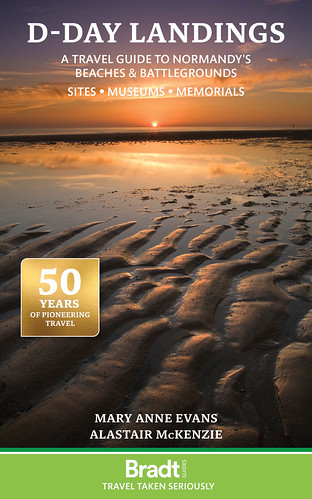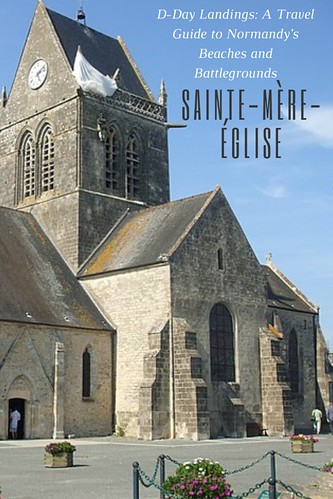Published to commemorate the 80th anniversary of the military mission that changed World War II, D-Day Landings: A Travel Guide to Normandy’s Beaches and Battlegrounds is Bradt’s new guidebook to visiting beaches, memorials, museums, battlefields, and other sites associated with D-Day and the Battle of Normandy (Operation Overlord). A simple-to-follow, portable guide for independent travellers, it will help visitors to explore World War II history.

Written by two experienced travel writers with expertise in France and military history, D-Day Landings is designed for visitors who want to see all or part of Normandy. Covering the ground from the D-Day landing beaches (Sword, Juno, Gold, Omaha and Utah) up to the Falaise Gap and Cherbourg, it encompasses both every major site and a host of smaller, less well-known locations – venturing well beyond the coast to include sites associated with the capture of Cherbourg (D+20) and the closing of the Falaise Gap (D+76), which marked the end of the Overlord campaign.
The book is organised geographically in a lawnmower pattern along the landing beaches and then back again through the inland battlefield locations, encouraging readers to explore the less well-known but critically important Battle of Normandy sites. D-Day Landings also uncovers unexpected features such as a ‘concrete panzer’ pillbox topped by a tank turret around which Utah Beach Museum was constructed.

Sainte-Mère-Église, Normandy, June 1944
Public domain: US Army
Quirky snippets and human stories abound; learn how Lord Lovat’s Commando Piper Bill saw himself as a ballerina or how the Utah Beach landings were accidentally more successful than planned.
The guidebook has a comprehensive index of the military units mentioned, so that families of veterans, and those with an interest, can quickly and easily find locations that are relevant to them.
Bradt’s D-Day Landings will be an essential tool for planning trips to Normandy, and a companion on the journey itself, for military history enthusiasts, people with family who fought in Normandy and holidaymakers keen to make the most of Northern France.
Here is an excerpt about the D-Day landing history of Sainte-Mère-Église:

Sainte-Mère-Église, with Dummy Parachutist
Wikimedia Commons: Elliesram13, adapted by Wandering Educators
This town was a key target for US paratroopers on D-Day, and is still a key target for tourists today, being pretty much dedicated to the battlefield tour industry. The town centre is an open square dominated by the church itself, with a permanent reminder of paratrooper John Steele, in the form of a mannequin dangling from a parachute, caught up on the church tower.

US Paratrooper, representing John Steele (paratrooper), 82nd Airborne, june 6th, 1944, bell tower of church of Sainte-Mère-Église, Manche, Normandy, France.
Wikimedia Commons: Jebulon
In the early hours of 6 June, most of the 505th Parachute Infantry Regiment landed in and around their drop zone on the western outskirts of Sainte-Mère-Église. However, two aircraft misdropped their 30 paratroopers from F Company into the town itself. Unfortunately, an incendiary bomb from an earlier raid had set a villa on fire (where the Airborne Museum is now), and instead of being asleep, the locals were all gathered in the town square, with around 50 German soldiers from the local garrison, passing water buckets to the fire brigade. At that moment, 20 paratroopers landed in the square itself and Steele’s parachute got caught on the church tower. Dangling helplessly, he tried to play dead, but after 2 hours he was captured by the Germans. Twelve of his comrades died. (He actually got caught on the west side of the tower, to the left of the clock, but the mannequin is hung on the south side because it is more visible. And he wasn’t alone: paratrooper Kenneth Russell got caught on a gargoyle on the roof of the nave below him, but managed to cut himself free.)
The fighting in and around Sainte-Mère-Église carried on until noon on 7 June, when ground forces from Utah Beach arrived. John Steele escaped his captors and returned to his unit, and survived the war.

Sainte-Mère-Église Coat of Arms
Wikimedia Commons: Manassas
Around Sainte-Mère-Église
Five kilometres west of town, on D15, and 400m from Cauquigny Church in La Fière, there is a memorial to Private First Class Charles DeGlopper of the 325th Glider Infantry Regiment. DeGlopper, from Grand Island, New York, already stood out among his comrades when he first joined up: they had problems finding a uniform and boots to fit his 2.1m, 109kg frame. Aged 22, he had already fought in north Africa by the time of D-Day. His company was charged with taking the causeway over the Merderet River in the early hours of 9 June, but a group of soldiers got separated in the darkness and emerged on to a nearby road to find themselves facing superior German forces on three sides. While most of the men retreated through the hedge, DeGlopper began firing his Browning automatic rifle to draw attention away and allow his comrades to escape. He was wounded almost immediately but continued to fire, dropping to his knee when he was hit a second time, before eventually succumbing to his wounds. For his heroic self-sacrifice he was posthumously presented America’s highest award, the Medal of Honor. The tall black stele here has an etched image of DeGlopper firing his gun from the hip.
Heading south of La Fière, 2.4km away, there is a memorial to Captain Ignatius P Maternowski (by 371–374 Gueutteville, just off D15). In the early hours of 6 June, many paratroopers of the 508th Parachute Infantry Regiment were scattered around the small hamlet of Gueutteville, which was garrisoned by German, Georgian and Mongolian troops. Some paratroopers went to a French café to seek directions and pretty quickly wounded paratroopers began to gather here. The café became an aid station and the senior officer, Father Maternowski – a catholic chaplain with the 508th PIR – showed incredible bravery by walking through the village unarmed to speak to the German commanding officer, to ask him to recognise the café and another building as non-combatant medical facilities under the Geneva Convention. Amazingly, he wasn’t shot and the German officer returned with him to check the buildings and the condition of the wounded. Afterwards, Father Maternowski escorted the officer back to the upper part of the hamlet, but as he was returning to the aid station he was shot in the back and killed. It’s not clear whether a sniper shot him, or maybe the officer himself. This remembrance spot, with its etched image of Father Maternowski giving the last rites to a dying soldier, is located next to the spot on the road where he died.

Le bâtiment C-47 du Musée Airborne à Sainte-Mère-Eglise
Wikimedia Commons: Musée Airborne
About the authors

Mary Anne Evans has over 35 years’ experience writing and editing guidebooks and travel articles. Having started visiting France when she was five, she now owns a house in the Auvergne and runs her own specialist website (Maryannesfrance.com), which outlines suggestions for trips to French regions, previews forthcoming events and offers practical travel advice. Normandy has always been one of her favourite destinations thanks to its proximity, long sandy beaches, great cities and shared history. A visit in 2008 to the newly opened Visitor Centre at the Normandy American Cemetery and Memorial revealed compelling and emotional stories about ordinary individual soldiers involved in the fighting. It set Evans off on many journeys around the D-Day Landing beaches. New sites like the British Normandy Memorial, which opened in 2021, have revealed fresh insights as she discovers ever more about the history of Operation Overlord.

Alastair McKenzie was a travel editor and presenter in local, national and international radio (Classic FM) for a decade from 1989, before moving online where he became an active member of the travel blogger and content creator community, and a regular speaker at social media travel conferences. A member of the British Guild of Travel Writers since 2002, he now runs a specialist niche blog (mechtraveller.com), which focuses on mechanical, technical and historic points of interest for travellers, including battlefield sites and military museums. Like the Allies, he first came to Normandy as a young man by sea. During the eighties he sailed and skippered yachts around most of the harbours on the European coast from Holland to Spain, including Ouistreham and Cherbourg. Since then he has explored most of Normandy by land and written about its key D-Day sites.
About Bradt Guides:
Founded in 1974, Bradt Guides is the largest independently owned travel publisher in the UK and US. Its guidebooks cover 150 overseas destinations, many of which are not covered in depth by other travel lists. New titles for 2024, the company's 50th anniversary, include Saudi Arabia, Greenland and two books on regions of Japan (Hokkaido, and Okinawa with the Southwest Islands). Bradt also publishes wildlife guides, travel writing, the award-winning ‘Slow Travel’ series of regional UK guides, and a range of colour guides to getting out and about in Britain, including the bestselling Paddling Britain.
